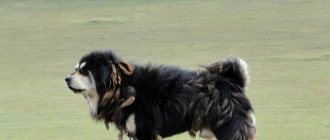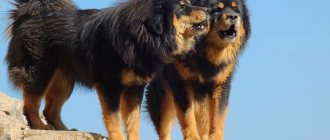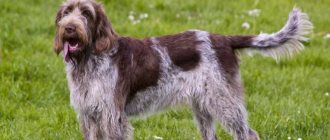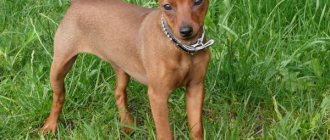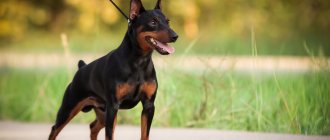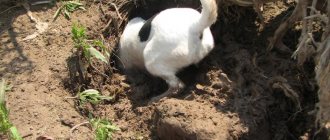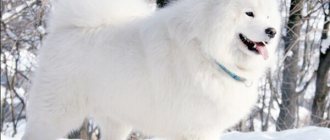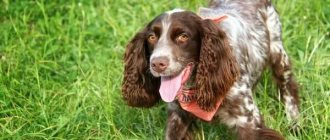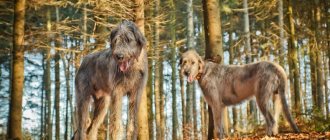Many dog lovers know that the Tibetan Mastiff is considered the most ancient breed and the progenitor of many dog breeds.
However, there is another little-known breed, which, as a result of recent research, can claim to be the oldest.
This is a Buryat-Mongolian wolfhound or Khotosho. She is poorly known among non-professionals. Let's talk about this dog, what it looks like, where it came from, whether it can be kept at home and learn other interesting facts.
Photo: wikimedia.org
History of the origin of the breed
Since ancient times, Khotosho were widespread in Central Asia, Tibet, Buryatia and Mongolia. They were faithful companions of man in all spheres of his life: hunting, guarding home and livestock, as a huge nanny for the owner’s children.
It is interesting that many legends are associated with this breed, or rather its origin.
The most famous of them:
- The ancient ancestor of the breed, a female Buryat-Mongolian wolfhound named Sarama, served directly the god Indra. She was distinguished by a special black and tan color. But the main feature was the presence of red spots on the dog’s forehead, which were located surprisingly symmetrically above the eyes. This gave the impression that the dog had four eyes. The ancient Buryats believed that a dog brings happiness to the house in which it lives. This belief has survived to this day;
- Khotosho once saved people from starvation by persuading Buddha to save grain on ears of grain.
Currently, animals of this breed occupy a special place in Buddhism. They are revered as sacred.
The formation of the breed proceeded through natural selection. Almost no selection was carried out. Except for selecting the strongest puppies from the litter. By the end of the 20th century, the breed was in danger of extinction. No one was involved in breeding.
The revival of the breed is associated with the activities of two enthusiasts: Marika Teregulova and Nikolai Batov. They organized expeditions to remote areas of Buryatia, where representatives of the breed could still be found. Breeding nurseries were organized in which the first offspring were obtained.
They created the breed standard. True, so far it has not been possible to achieve official recognition, and the breed is still considered rare. But she is no longer in danger of disappearing.
In addition to the most famous and official name, you can hear such names as: Mongolian Shepherd, Caucasian, Hun dog, Tibetan dog or simply wolfhound.
Photo: topsimages.com
Brief historical background
The Khotosho is an extremely ancient indigenous breed of canid . It is quite possible that they are even much older than those considered to be the ancestors of most of the currently existing breeds of Tibetan mastiffs. This is confirmed by artifacts (remains of dogs, etc.) found during excavations in the Ivolginsky Hun settlement (Republic of Buryatia), which are at least three thousand years old. The Mongols and Buryats took bankhars with them on hunts and on long marches. Dogs guarded herds and human dwellings, and also accompanied local shamans everywhere. The Tibetan wolfhound was attributed with certain magical qualities. The giant dog was revered in Buddhism, it guarded temples and was considered sacred.
An ancient legend says that the ancestor of the Buryat Shepherd Dogs was a female named Sarama, who helped the god Indra (king of the gods and ruler of the heavenly kingdom). The dog had two pairs of eyes, which made it an excellent watchman and guard. Modern Buryats believe that animals that have symmetrical contrasting spots above their eyes, forming a “four eyes,” bring happiness to the house and protect it from all kinds of misfortunes.
Bankhars to this day faithfully guard the homes of the Mongols
However, at the end of the last century, the Buryat-Mongolian wolfhounds disappeared almost completely. Nikolai Batov took charge of their revival, who organized several expeditions to discover surviving individuals and search for Buddhist documents in monasteries, and also collected legends, beliefs and other data in order to restore the appearance of these dogs as reliably as possible. Based on the information collected, a breed standard was developed by 2000, and on April 18 of the same year, the breeding commission of the RKF (Russian Cynological Federation) registered Khotosho as a separate breed group.
The international canine community does not yet recognize these wolfhounds.
Description of the breed
The breed standard was established in 2006.
Breed requirements:
- Males always exceed females in size. Height at the withers: male - not less than 0.74 meters, female - not less than 0.66 meters. The dog is considered large and the weight of a male dog can reach up to 80 kilograms.
- The head is large, with well-defined cheekbones;
- The legs are very muscular, above average length;
- The dog's body is developed, with large muscles, barely noticeable under thick fur;
- The ears are triangular, medium in size, hanging;
- The eyes should be oval shaped. Color - from amber to dark brown. There are wolfhounds with blue eyes, which is considered a breed defect;
- Scissor bite. The dog's teeth should be very white, tightly adjacent to each other;
- The coat is quite hard combined with a dense soft undercoat;
- There are types: with long hair (hair length up to 30 cm), medium hair (up to 10 cm) and short hair (up to 5 cm). Despite the difference in coat length, all individuals shed equally heavily;
- The classic color is black and tan with a small white spot on the chest. It is preferred, but brown, brown, gray, black colors in various combinations are allowed;
- It is believed that Khotosho is a crossbreed of the Buryat-Mongolian wolfhound; less stringent requirements are imposed on them.
Difference between Khotosho and Bankhar
Often these two concepts merge and it is believed that these are two names for the same breed. This is wrong. Khotosho is a mixed breed, a yard dog. The word “hotosho” itself is translated from Buryat as “yard dog”, “yard guard”.
But the bankhar is a dog that carries all the characteristics of a pure breed. From the Mongolian language it is translated as “puffy”, “fluffy”, “filled with wool”.
They differ in appearance: the bankhar is larger than the bankhar, because the Mongols strictly observe the size of dogs; excess weight will interfere with the bankhar's movement.
Photo: bankhar.org
Blog: 9 entries
Yard wolf
These dogs can even work as nannies
There are not even a thousand purebred representatives of dogs of this breed in Russia; the number of breeding producers is in the dozens. Khotosho, or Buryat-Mongolian wolfhound (BMW) - behind this threatening name hides a completely sociable, I would say, even good-natured creature. “Not good-natured, but balanced,” corrects me Evgenia Manykina, who has been training this breed in Moscow for more than 10 years. – “Buryats” can be excellent guards and smart hunting partners. In their historical homeland - Buryatia - they even go bear hunting with them. And their balanced character makes them excellent nannies.
The perfect dog
“My acquaintance with Khotosho happened in absentia back in the 1970s,” recalls Evgenia. “Then, in the second-hand book department of a capital bookstore, I came across Boris Kostyukovsky’s stories “A Trip to the Sun” and “Where the Sun Hides.” They were born from an essay dedicated to Buryat shepherds and their children. One of the heroes is a Buryat boy Andreika Nimaev, who had a dog named Nyanka. How I wanted such a dog - smart, obedient, quick-witted and independent! I went through all the breeds known at that time in the Soviet Union, but not a single one corresponded to the one described - neither in appearance nor in character. As a result, the Caucasian Shepherd Rada appeared in our house. From her I tried to “sculpt” my ideal dog. And after two years of training, I received a wonderful assistant and companion in the best sense of the word - a companion with whom I was not afraid of anything or anyone. But still it was not quite the same. No matter how well a Caucasian is trained, the breed’s traits cannot be hidden anywhere: neither independence, nor stubbornness, nor a tendency to be proactive. Only 20 years after we first met, they showed me my dream. True, her name was not Nanny, but Terresa, but this did not matter at all. For two years we argued with her owner, but in the end I got a puppy. Rika’s appearance didn’t quite match my expectations, but what a character! She did not disappoint my expectations in any way.
Everyone finds something of their own
Independent, but flexible, surprisingly flexible and trainable, balanced, but capable of instantly exploding in a rapid attack. In short, the dream of any trainer - from an inexperienced amateur to a tough professional. Even if a “Buryat” accidentally steps on his paw, he can simply move away. True, few people want to experiment. It’s better not to joke with a dog that weighs 50–70 kg and grows more than 70 cm at the withers. These dogs have always been distinguished by their impressive size. In Buryatia they are called khotosho, which means “yard wolf”. Smart dogs herded the cattle of nomads in Transbaikalia and protected their homes from wild wolves. Good watchmen and shepherds, reliable protectors and wonderful companions for humans - nevertheless, in the 1980s. this breed was close to extinction. They were preserved by dog breeders from Buryatia. They managed to find almost the last few individuals in Transbaikalia and Mongolia and brought more Tibetan dog puppies from Lhasa to restore the breed. As a result, in 2000, the breed group of Buryat-Mongolian wolfhounds was registered and a breed standard was adopted. It’s an amazing thing: when you look at the “Buryats”, you see a variety of breeds in it. The long-haired ones with a large head and wide chest resemble Newfoundlands, the black and tan smooth-haired ones look like overgrown Rottweilers. Kids want to be a different story altogether. If you don’t know the exact breed, a puppy can easily be mistaken for both a Shepherd and a Caucasian. “That’s for sure: “my puppy looks a little like a bulldog and mastiff,” laughs Evgenia Nikolaevna. – Everyone finds something different in this breed. According to Evgenia Manykina, the “Buryats” were generously gifted by nature, but without any frills or external gloss. This is largely why the breed, which has existed for several centuries, was officially registered only 10 years ago.
From circus performer to security guard
“Outwardly, these animals may not seem impressive to some,” Evgenia continues. – For example, at one time, Asian shepherd dogs had their ears and tail docked, while Caucasian shepherd dogs had their ears docked. Here nothing is cut down, what Mother Nature gave it grows. I'm quite happy with this. I’m not a showman, my business is work, and they have everything for work. There is speed, there is obedience, there is mobility, intelligence, and the absence of laziness. And the handling is almost perfect. That's for sure. We calmly walk through the park, but the powerful Hotosho Beetle controls the situation. You can feel it. Buryat-Mongolian wolfhounds are curious by nature. They are interested in any object that appears in their familiar environment. Anything that doesn’t stand, lie or move correctly arouses their keen interest and will definitely be indicated - the dog will certainly attract the owner’s attention to this object. – The dog can remain in this working state for hours without tiring it. And in case of danger, the dog reacts with lightning speed, depending on the situation. “Buryats” do not grab with a death grip, but “stamp” with several bites. “They are surprisingly smart,” continues Evgenia Nikolaevna and throws a stick to the Beetle, which is lost somewhere in the snow. So that the dog fails to find it on the fly, but he patiently combs meter by meter and still finds it. “Ay, clever girl,” praises the furry giant Evgeniy, who cuddles up to him with happiness like a puppy. – Believe it or not, you can make anything out of “Buryats”: from a circus dog to a security guard. – Who is smarter: females or males? – I ask Evgenia. – Bitches’ behavior is traditionally richer, but with males it’s easier. – Is there a delicacy for which the “Buryats” will give everything? - Weasel, but you don’t need to babysit with this dog. You can communicate with someone on an equal footing, without fear that they will try to take a leading position. - So I believed that this big guy was sitting quietly in a corner of your house on the rug... - No, not in a corner. He took root on a rug in a small room under a table. By the way, Buddhism, practiced in Buryatia and Mongolia, is the only Eastern religion where the dog is not only not unclean - on the contrary, it is a sacred animal. A black and tan dog is believed to bring happiness to the house. Therefore, “Buryats” are not only not prohibited from entering their homes, they literally live side by side with their owners, not only guarding property and livestock, but also taking care of children from the cradle. For example, in our family, Zhuk listens to everyone, although for him, of course, I am the head of the clan, but not to the detriment of others. And for many service dogs, loyalty to one comes to the detriment of the rest of the household, even to the point of direct oppression.
Happiness is when the owner is in the house
BMWs belong to the breeds of late formation - their growth in height ends only at 2 years, dogs are finally formed by 3.5–4 years. For proper development, they require great physical activity: in conditions of limited mobility, the muscles do not gain the required volume, and even a well-fed dog looks skinny. “The price of Khotosho puppies is considerable - from $1000, and it directly depends on external data and character,” says Evgenia Nikolaevna. – In our nursery, for example, I strictly reject overly aggressive or insecure kids. Age matters: the older the puppy, when the likelihood of late marriage (say, lack of teeth) is minimized, the more expensive it will cost - up to $4,000. After a year, we, as a rule, do not sell dogs - they are already trained, and “you need such a cow yourself.” My goal is not to sell puppies, the main thing is to improve the quality of the breed. My dogs then go to work on objects. One such worker, nicknamed Lyubava, of a rare red color, who was sent from the bus depot to her native land during her heat, appeared before me. She doesn’t need sausage, she doesn’t need the caresses of familiar dog handlers, she would like to sneak onto the bed to be closer to “mother”, Evgenia Manykina, and put her muzzle on her lap. This is dog happiness!
Help "VM"
Since March 2000, Buryat-Mongolian wolfhounds have been included in the Stud Book of Russia, have brands and pedigree documents issued by the Russian Canine Federation.
Author: Olga Shcherbakova
https://www.vmdaily.ru/article/111449.html
Character and behavioral characteristics
A feature of the breed is the late maturation of individuals. The animal becomes fully formed psychologically only by the age of three. Males mature later than females. But this does not prevent them from performing their basic functions at a very young age. Even the smallest puppy will protect its territory, its owner and his family members.
You need to understand that the wolfhound is very human-oriented and it will not be enough for him to see his owner only during feeding and walking. He needs mandatory daily communication, play and affection from a person.
These hulks, whose height on their hind legs is comparable to the height of an adult, love children very much and treat them with caution and emphatic respect.
The dog's character is such that he can hardly tolerate strangers. But he will never rush without a clear reason and warning. They have a very stable psyche, but they are not phlegmatic. Show appropriate aggression when necessary.
Photo: wikimedia.org
BMW is man's true friend
2K 5 min.
Aesthetes, accustomed to dealing exclusively with breeds on whose appearance generations of diligent breeders have worked for years, if not centuries, are unlikely to be able to appreciate the dim beauty of the Buryat-Mongolian wolfhound, a distant relative of the Tibetan Great Dane. Everything he has is given to him by nature. And no tricks - this purely aboriginal breed has not yet been subjected to human influence. So, apparently, the Buryat-Mongolian wolfhound is one of the oldest dog breeds, which has survived to this day in almost the same form in which its ancestors roamed among the yurts in those days when yurts were considered the latest achievement in housing construction.
Large but not heavy, red, black or black and tan, Buryat-Mongolian wolfhounds look a bit like a small bear. These are plump, uncouth hulks, although in fact they are agile, fast, cheerful, energetic, brave and tireless dogs. This breed has other names - for example, “khotosho”, which in Buryat means “yard wolf”, as well as “banhar” - and in Mongolian this is “plump, thick, fluffy” (at least that’s what they say people boasting of their knowledge of the Buryat and Mongolian languages). Although, in general, he is not the least bit fat, just big (50-60 kilograms with a height at the withers of up to 75 centimeters) and indeed can be quite fluffy, unless, of course, he belongs to the short-haired variety - there are such.
Our few owners of dogs of this breed often shorten the long “Buryat-Mongolian wolfhound” to the modest “BMW,” which misleads uninitiated listeners. And the uninitiated among the listeners may be the majority - although the Buryat-Mongolian wolfhounds originated in our native Buryatia and brotherly Mongolia, few people still know about their existence. But what can we say if some cynological organizations still deny the right to be considered a breed, and this despite their ancient history. In a word, now there are at most a couple of hundred dogs of this breed living in Moscow, and that’s good, not even that happened recently.
People familiar with the life of the Buryats claim that there was (and perhaps still is) an opinion among these people: if a shepherd completely entrusts his flock to a dog, then very soon the shepherd will have big troubles, fraught with the complete disappearance of his entire family. In a word, a good Buryat shepherd must personally walk his sheep, from which we can conclude that BMWs have never been herding dogs. But yes, they were guards. It is no coincidence that they were called yard wolves: sitting in the yard, looking after all movable and immovable property and at the same time raising the master’s children - this is what Khotosho considers the main task of his life. In addition, in their habitats there lived people who never considered dogs unclean, so generations of bankhars grew up in a completely friendly atmosphere: no one bothered them, their visits to yurts were not only not condemned, but, on the contrary, were joyfully welcomed. This is how it happened that the Buryat-Mongolian wolfhounds over time turned into very homely dogs, very attached to both housing and its inhabitants. They don’t even dream of running away in search of adventure, because more than anything else they want to take care of what they consider their property.
Although if you look at it, they don’t really need people as a source of life’s blessings - these dogs are still so close to nature that they can easily live without their owner’s care. An example of this is one young BMW, taken by its new owners to live in the Bryansk region. It so happened that she did not have time to get used to new people - the move happened literally five minutes after she was handed over from hand to hand, and the change of BMW owners, even young ones, is not easy for them - and therefore, as soon as she arrived at the place, she was frisky the dog immediately retreated into the surrounding forests. There she wandered for two weeks, watching her new owners from afar - apparently, she was wondering whether they were suitable for her as friends. Until the decision was made, she not only did not approach them, she even, just in case, did not eat all sorts of goodies that the alarmed people had laid out under all the bushes. Only two weeks later, the stubborn young woman finally decided that these owners would suit her, she relented and came to live in her new home. But what is most surprising is that this young and inexperienced BMW looked completely different from what a city dog should have looked like, hanging out in the forests for many days without food, drink or regular brushing. She didn’t lose weight or go hungry one bit, and this would be understandable if chickens and other small livestock suddenly began disappearing en masse among the neighboring villagers. But no, she didn’t want to steal anything from anyone, and only she knew what she ate. Maybe she hunted wild boars or bears.
However, for all its independence, the Buryat-Mongolian wolfhound categorically does not want to do without people. This very large dog at any age is gentle, affectionate and playful like a puppy, which in no way detracts from its protective qualities. Although the BMW is always on the lookout, you can’t tell from its appearance - it’s calm and seemingly relaxed, it doesn’t look around the surroundings with a gloomy look, doesn’t glance suspiciously at everyone it meets and crosses, and isn’t in a hurry to get involved in a fight. Dogs of this breed, as a rule, are not suspicious - they know how to distinguish a far-fetched danger from a real threat and react to everything quite adequately. Well, if they doubt something, they will turn to the owner for advice. For example, there is one door on their territory that is always closed. And suddenly one day the BMW sees that forever, as he thought, the locked door remains open! The vigilant dog cannot pass by such an outrage - and so, not knowing how to evaluate the new state of affairs, he runs after his man and brings him to have a look.
If relations with other dogs lead to a fight, then the Buryat-Mongolian wolfhound will be powerful and very dangerous. Fortunately, he only gets involved in a fight when there is no other choice. Non-conflict and non-aggressive, he always tries to settle everything in an amicable way. He has a lot of patience - some quarrelsome little dog can bully a BMW as much as he likes, he won’t even move his ears, in extreme cases he can pretend that he’s about to rush out - and he himself will run past, skillfully turning a potential fight into fun running around. However, he remains so cute only until he senses a real threat...
In terms of learning all sorts of dog tricks, he also has no equal - he trains easily, quickly and willingly, because in the learning process he sees not a violation of his canine rights and freedoms, but another opportunity to establish closer relationships with a person. Moreover, they work only for praise and affection, and not for a tasty piece - these dogs are not exactly indifferent to food, but delicacies do not hypnotize them and they will not sell their homeland for a piece of sausage.
In an apartment, the BMW doesn’t take up much space—it will find a corner and lie there, not minding at all if people step over it every now and then. Moreover, he won’t want to win a better place for himself by building kittens, dwarf Spitz dogs and other little things that live in the house - these powerful dogs are very lenient towards all small fry, so they can get along with literally anyone. As for children, the BMW is their best friend and protector: a smart dog understands that the child is still not a full-fledged owner, but does not neglect even the children’s commands. However, if he doesn’t like the command, he will carry it out with a slight hesitation, with an expression on his dog’s face “here you go, choke”! This dog cannot stand rudeness - he is offended and sad, which is easily read on his large and very expressive face. In general, the obedience of the Buryat-Mongolian wolfhound is by no means unlimited, especially if we are talking about a disorganized baby. If this dog sees that a foolish child is preparing to misbehave - for example, he recklessly climbs into the water - the noble hoto simply will not allow him to go too far (this dog swims like a rescuer).
In a word, with such a dog you can feel like you are behind a stone wall. And the BMW itself only requires walking, and quite a lot - these dogs need physical activity. And you also need to comb him sometimes, but don’t be afraid when in the summer your fluffy hoto suddenly flies around like an autumn birch tree and becomes almost naked: this is normal, by autumn the former luxury will certainly grow and allow this dog to spit on any frost. The health of these dogs is excellent; they live for 15-16 years, which is simply a record for such a large dog. In a word, if anyone wants a real dog, a faithful friend and protector, a short journey awaits them on the website https://pitomnikgamaun.ru, where from time to time photographs of adorable plump babies of the Buryat-Mongolian wolfhound appear (about 60,000 rubles each).
Education and training
Such a dog is not suitable for a person who is just beginning to learn the basics of education and training. This is a very psychologically serious dog. At the same time, it is a very simple animal. Teaching him basic commands will not be a problem.
However, in the matter of education and training, one must be guided by the basic principles: patience, consistency, and physical force must not be used. You shouldn’t give in if the owner has banned something – it’s forever. You cannot give in, but it is also not permissible to insist on your position by force. Plus, it can be downright dangerous. You need to start raising a puppy as soon as it gets into the family.
???❤ #Hotosho #Chuck #dog pic.twitter.com/uAsYFWgGgD
— Anita Tsoy (@anitatsoi) January 27, 2022
Diseases and care
The breed is distinguished by amazing health and strong immunity, despite its enormous size. Perhaps the presence of wild animals in the ancestors - wolves - has an effect.
Life expectancy is up to 23 years. There are no genetic pathologies, but we can identify diseases that are common to all large breeds:
- Hip dysplasia. This is a congenital disease, usually its presence appears towards the end of the first year of life;
- Heart diseases;
- Joint problems;
- Bloating and volvulus of the stomach.
These diseases are typical for all large animals, but are manifested to the least extent in Mongolian Shepherds. As a rule, such dogs live outside because they require a lot of free space. But they are also suitable for keeping in an apartment, if its size allows.
Only the animal’s fur needs careful care, as it sheds once a year, but very profusely. Daily brushing is required during this period.
Ears, eyes and teeth require routine periodic care.
Photo: wikimedia.org
Nutrition of the Mongolian wolfhound
The quality of a yard wolf's diet is literally reflected in its fur. If it is thick and shiny, the dog receives all the necessary substances. A pet's dull, brittle fur is a reason to reconsider its diet. It can be natural or consist of dry food. In any case, the proportion of protein is important. You should have at least 50% of it in your diet.
Among natural products, all types of meat, cereal porridges, dairy products, and vegetables are recommended for wolfhounds. At least 800 grams per day for fillets and soup products. Large male dogs need one and a half kilograms of meat per day.
It is advisable to add a tablespoon of fish oil to a natural meal, supplementing the menu with mineral supplements. They are purchased at pet stores. If the dog is on dry food, it already contains vitamin supplements.
However, pelleted foods come in different classes. Cheap additives have a minimum. It is worth thinking about additional mineral complexes. Then you in the photo and in real life with your brilliant appearance and strength.
Males are noticeably larger than females
The Khotosho breed is massive. However, dogs should not be overweight. Additional mass means additional pressure on bones and joints. If pressure acts in conjunction with an insufficient vitamin and mineral nutritional base, the wolfhound’s backbone becomes distorted. This is a manifestation of rickets.
The pet's nutrition must be not only complete, but also properly structured. Before the walk, they don’t want to feed you. After jogging, the dogs are given a drink. The portions are small, but they are given often - about 7 times a day. This avoids the digestive problems common to all large dogs.
Feeding
The breed is very unpretentious in nutrition. You can feed both natural products and prepared foods. Interestingly, most breeders of the breed choose natural nutrition.
Rules for creating a natural diet:
- The share of meat products is 2/3 of the daily diet;
- Choose lean meat: beef, turkey, chicken, offal;
- Cereals are mixed with the meat;
- The diet includes boiled sea fish;
- Sour milk - low fat content;
- Vegetables can be anything. The exception is tomatoes;
- You can give a raw egg twice a week.
It is necessary to strictly monitor the serving size. In addition, you need to follow the feeding rule regarding the walk: an hour and a half before the walk and no earlier than an hour and a half after it. Otherwise, the dog may be at risk of gastric volvulus and will require surgical intervention.
As for ready-made dry food, there are special requirements for it: the food must be premium class, designed for large dogs, and preference should be given to holistic food.
Photo: ytimg.com
Caring for the Buryat-Mongolian Wolfhound
The bankhar will feel most comfortable living in a country house with a spacious courtyard or enclosure, which is equipped with an insulated booth . The dog can live outdoors all year round, because its warm and thick coat reliably protects it from bad weather. Some individuals even flatly refuse to use the individual housing provided for them.
Your pet will be able to adapt to a confined apartment space if you provide it with the proper level of physical activity on long (1–1.5 hour) walks.
Caring for hotsho is as follows:
- once a week, comb the wool with a slicker or furminator to remove dead hairs and prevent the formation of tangles (during active shedding in spring and autumn, this is done daily);
- bathe no more than 1-2 times a year, using zoo shampoos;
- brush their teeth once every 5–7 days using a brush (finger attachment) and special toothpaste for animals;
- Every week they examine the eyes and ears, clean them with cotton pads or swabs with veterinary lotions;
- Trim the claws about once a month if they do not grind down on their own.
It is best to keep the bankhara outdoors, in a fenced, spacious enclosure.
Most owners feed their Tibetan wolfhounds home-cooked, freshly prepared food. The natural diet includes:
- fresh raw meat of lean varieties (horse meat, beef, goat meat, etc.);
- offal, entrails, cartilage, veins, tripe, etc.;
- eggs;
- boiled fish;
- porridge (rice, buckwheat);
- bran;
- vegetables, fruits, herbs;
- fermented milk products (yogurt, kefir, cottage cheese, etc.) with minimal fat content;
- unrefined vegetable oil;
- vitamin and mineral supplements.
However, dry store-bought food is not contraindicated; it is only important to choose products of at least a premium class, intended for large and giant dog breeds (Monge Superpremium Dog Maxi Adult, Pro Plan Adult Large Robust, Fitmin Maxi Maintenance, etc.). Adults are given food twice a day (morning and evening) at the same time. Puppies need to be fed more often (3 to 6 times).
Wolfhounds are prohibited from giving sweets, baked goods, smoked meats, sausages and pasta, as well as fatty, fried, highly salted foods and tubular (chicken, duck, etc.) bones.
Training
Buryat-Mongolian wolfhounds are well trained and quickly remember all commands. However, due to their tendency to be independent, the learning process can present some difficulties. Such a dog should be handled by an experienced and strong-willed owner who will not give it any concessions. A puppy is trained from 2–2.5 months; an obedience course is indicated after six months.
The breed is characterized by late maturation; these wolfhounds reach maturity only at 3–4 years.
Khotosho are usually not trained specifically for guarding, since all the necessary skills are in their blood and are innate. Before taking the protective guard service course, it is necessary to check the animal’s mental stability and controllability, since by law dogs with these skills are equated to a dangerous weapon.
The bankhar's security functions are innate.
A large dog must obey unquestioningly and follow all commands. Our neighbors live with a Caucasian Shepherd dog, distinguished by its decent dimensions, which practically no one has trained. Having accidentally jumped out of the gate, she rushes headlong, absolutely not listening to her owners. So far the dog has not bitten anyone, but it frightens passers-by, especially small children, extremely, posing a potential danger to them.
Price and where to buy a puppy
An animal with excellent working qualities, which is the bankhar, is quite expensive. The cost of a puppy varies from 65,000 to 150,000 rubles. Such a high price is due to the low prevalence of the breed. But she is increasingly winning the hearts of dog breeders in Russia.
You need to be careful when buying a puppy. This should only be done in a specialized nursery. On the market you can find representatives of the breed that are much cheaper, but such a huge dog with an unstable psyche, bred outside a breeding kennel, can cause harm to its owner.
When buying a puppy of this breed, the owner is faced with an unexpected question - a nickname . After all, it’s quite difficult to come up with a name for such a thug, even with a calm temperament. In addition, the nickname that can be given to a fluffy, clumsy bear cub may not be at all suitable for the formidable guard that he will soon become.
What nicknames can you suggest? These are unlikely to be simple names such as Sharik or Druzhok. Fashionable ones - Amethyst, Baron - will not work either. The name of such a dog should reflect its ancient origins and sound serious. For example: Chingiz, Zavgar, Terra, Elba, Khatis, Hadisa, Khan, Hannah, Sheik and others.
In any case, the choice of nickname is up to the owner; often the name “comes” after the first meeting with a friend.
A killing machine growing? #hotosho #wolfhound pic.twitter.com/Z67rpVjPd5
— Photo from Ulan-Ude (@InstaUlanUde) March 19, 2016
Choosing a puppy
The population of Buryat Shepherd Dogs is small, so buying a puppy of this breed is not easy. There are several nurseries specializing in breeding this breed, the largest are located in Ulan-Ude (“Property of the Republic of Buryatia”, “Khotosho”). It is recommended to purchase a pet only from a reliable breeder who will confirm its pedigree with the necessary set of documents (puppy certificate, breeding patent, pedigree of parents, etc.).
It is sometimes impossible to distinguish a Buryat-Mongolian wolfhound puppy from a small Caucasian or mestizo, since the breed is not yet fully established and its representatives can be very different from each other. Some guidance can be the presence of a pair of contrasting light spots above the eyes.
Buryat-Mongolian Wolfhound puppies are easiest to find in Buryatia
Price of a puppy of this breed
The cost of a hot dog varies from 25 to 45 thousand rubles, depending on the potential of the puppy and the title of the parent couple. An animal without documents can be found in an advertisement for 10–15 thousand, but in this case there will be no guarantee of thoroughbredness.
